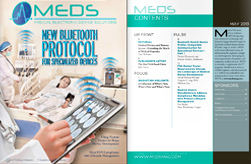From Functional to… Portable… Handheld… Wearable.
I have witnessed Mobile Health in action. Many ECG devices are portable, but now I have started to see wearable ECG. Last year I saw one by Imec. This year at CES I saw another wearable ECG using clothing as a sensor. It is made by Cardiosport based in the UK. (I like the company name).
A small device worn by a person will transmit ECG signals to another device, presumably used by a caretaker. When a person with a heart problem is placed in the “under observation” category, for the most part, the person is required to stay in the hospital or at a facility where the monitoring equipment is located. Now with this new device, the person can stay home in a familiar environment, wearing the device and move around freely knowing that the data signal can be monitored remotely. What a noble idea! Another company, AliveCor, has introduced a new device called the AliveCor Smartphone ECG using the iPhone to read the ECG signal. A special phone case was made with two electrodes built in. The electrodes can touch the hands or the chest for it to work. Once a proper connection is made, the ECG signal will be read on the iPhone using a special app. The device is going through the FDA clearance process and the company hopes to have products on the market this year.The implantable defibrillator is in a class all by itself. A friend of mine has an implantable defibrillator, and I have learned a lot from him about how his life depends on it. I came to appreciate the human aspect of it. The battery has limited life. Changing the battery means a hospital visit, where the doctor has to cut the body open to replace the battery or the unit. Average battery life is 5 years. I have heard new batteries with a 10-year battery life are being worked on. This means an additional 5 years without surgery. What about the concept of charging the unit wirelessly much like charging a cell phone wirelessly by placing it in a cradle? I imagine the user would only need to lie in a magnetic field to get charged up after a night’s sleep. But then I don’t know enough about how that magnetic field would affect the body.
Even though I am talking here about how the ECG devices are changing, the pattern of change applies to all the other medical electronic devices as well. This is partly due to the magic of semiconductors, which pack a lot of functions into a very small package. (See this issue’s “Overview of Medical Semiconductor Market and Applications.”) However, the brain of all these medical electronic devices is, in fact, in the software. It is a very important part of medical electronic device design. We will investigate this further in our next issue.




